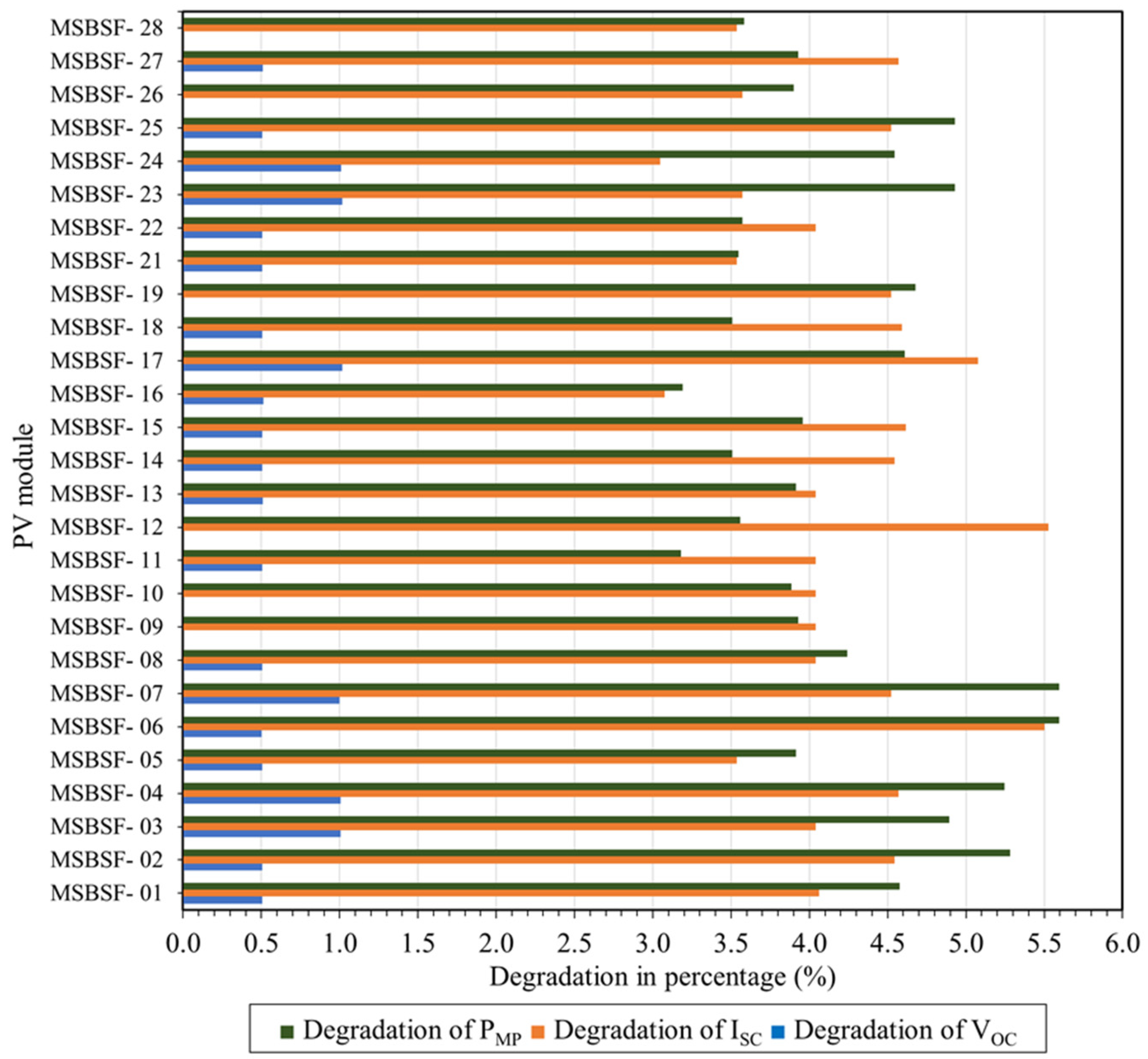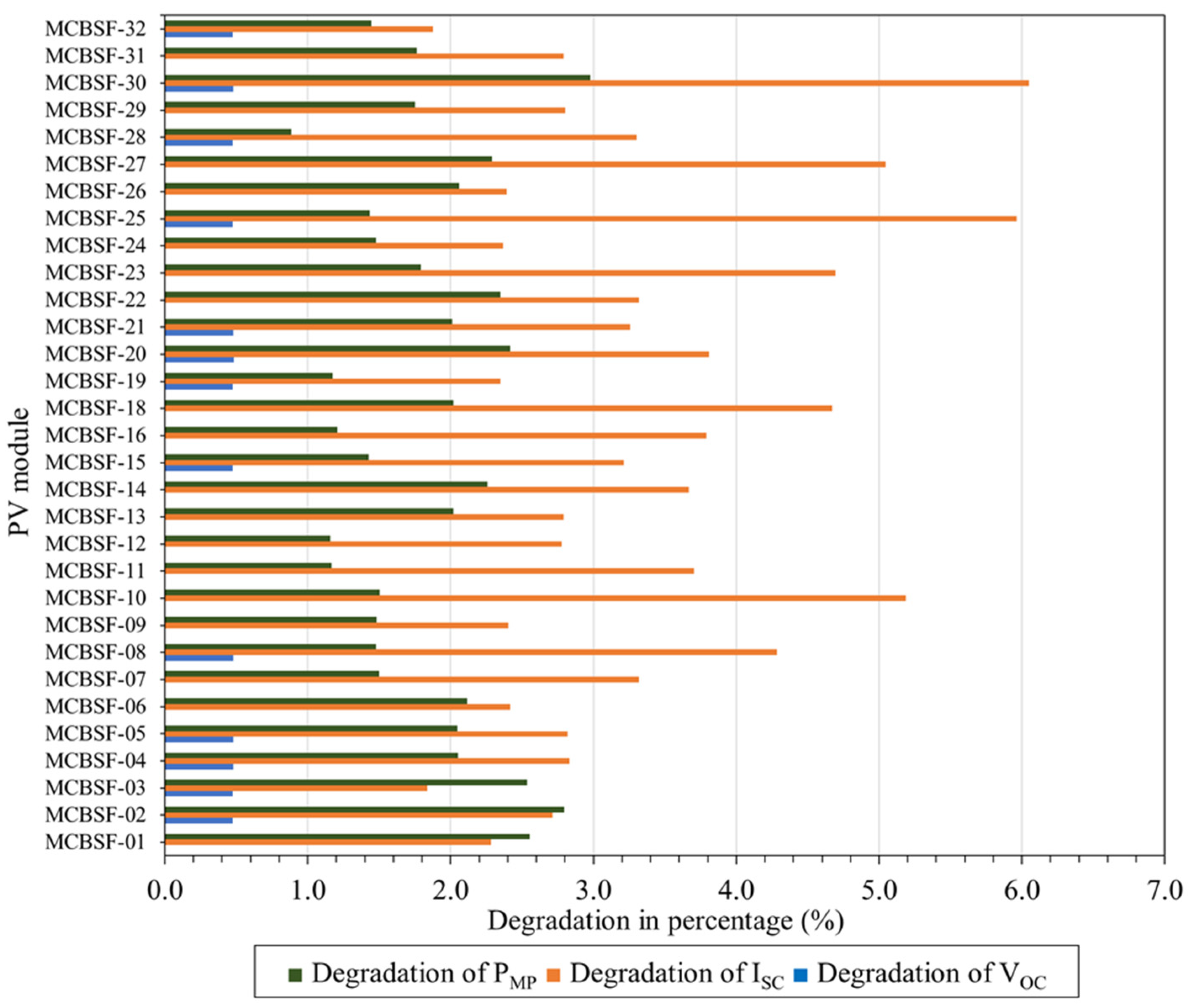Influence of Passivation and Solar Cell Configuration on the Electrical Parameter Degradation of Photovoltaic Modules
Abstract
1. Introduction
2. Materials and Methods
2.1. Manufacturing Process of Solar Cells and PV Modules
2.2. Characterization of the PV Modules and Degradation Evaluation
2.3. PV System Description
3. Results and Discussion
3.1. PV Modules with n+pn+ Solar Cells
3.2. PV Modules with Passivated Phosphorus-Emitter and Al-BSF Solar Cells
3.3. Comparison of Degradation in Devices with Different Configurations
4. Conclusions
Author Contributions
Funding
Data Availability Statement
Acknowledgments
Conflicts of Interest
References
- VDMA. The International Technology Roadmap for Photovoltaic (ITRPV), 8th ed.; VDMA: Frankfurt, Germany, 2017; p. 39. [Google Scholar]
- VDMA. The International Technology Roadmap for Photovoltaic (ITRPV), 14th ed.; VDMA: Frankfurt, Germany, 2023; p. 81. [Google Scholar]
- REN21. Renewables 2020 Global Status Report; REN21: Paris, France, 2020; p. 367. [Google Scholar]
- Green, M.A. The Passivated Emitter and Rear Cell (PERC): From conception to mass production. Sol. Energy Mater. Sol. Cells 2015, 143, 190–197. [Google Scholar] [CrossRef]
- Blakers, A.W.; Wang, A.; Milne, A.M.; Zhao, J.; Green, M.A. 22.8% efficient silicon solar cell. Appl. Phys. Lett 1989, 55, 1363–1365. [Google Scholar] [CrossRef]
- Wang, A.; Zhao, J.; Green, M.A. 24% efficient silicon solar cells. Appl. Phys. Lett. 1990, 57, 602–604. [Google Scholar] [CrossRef]
- Ballif, C.; Haug, F.J.; Boccard, M.; Verlinden, P.J.; Hahn, G. Status and perspectives of crystalline silicon photovoltaics in research and industry. Nat. Rev. Mater. 2022, 7, 597–616. [Google Scholar] [CrossRef]
- Lim, J.R.; Shin, W.G.; Lee, C.G.; Lee, Y.G.; Ju, Y.C.; Ko, S.W.; Kim, J.D.; Kang, G.H.; Hwang, H. A Study of the Electrical Output and Reliability Characteristics of the Crystalline Photovoltaic Module According to the Front Materials. Energies 2021, 14, 163. [Google Scholar] [CrossRef]
- Guerra, M.R.; Laita, Í.P.; Solano, M.G.; Pascual, J. In-field energy performance of solar PV module made of UMG silicon. IEEE J. Photovolt. 2022, 12, 1109–1115. [Google Scholar] [CrossRef]
- Kaaya, I.; Ascencio-Vásquez, J.; Weiss, K.-A.; Topič, M. Assessment of uncertainties and variations in PV modules degradation rates and lifetime predictions using physical models. Sol. Energy 2021, 218, 354–367. [Google Scholar] [CrossRef]
- Aghaei, M.; Fairbrother, A.; Gok, A.; Ahmad, S.; Kazim, S.; Lobato, K.; Oreski, G.; Reinders, A.; Schmitz, J.; Theelen, M.; et al. Review of degradation and failure phenomena in photovoltaic modules. Renew. Sustain. Energy Rev. 2022, 159, 112160. [Google Scholar] [CrossRef]
- De Oliveira, M.C.C.; Cassini, D.A.; Diniz, A.S.A.C.; Soares, L.G.; Viana, M.M.; Kazmerski, L.L.; Lins, V.D.F.C. Comparison and analysis of performance and degradation differences of crystalline-Si photovoltaic modules after 15-years of field operation. Sol. Energy 2019, 191, 235–250. [Google Scholar] [CrossRef]
- Kahoul, N.; Cheghib, H.; Sidrach-de-Cardona, M.; Affari, B.C.; Younes, M.; Kherici, Z. Performance degradation analysis of crystalline silicon solar cells in desert climates. Energy Sustain. Dev. 2021, 65, 189–193. [Google Scholar] [CrossRef]
- Atia, D.M.; Hassan, A.A.; El-Madany, H.T.; Eliwa, A.Y.; Zahran, M.B. Degradation and energy performance evaluation of mono-crystalline photovoltaic modules in Egypt. Sci. Rep. 2023, 13, 13066. [Google Scholar] [CrossRef]
- Belhaouas, N.; Mehareb, F.; Kouadri-Boudjelthia, E.; Assem, H.; Bensalem, S.; Hadjrioua, F.; Aissaoui, A.; Hafdaoui, H.; Chahtou, A.; Bakria, K.; et al. The performance of solar PV modules with two glass types after 11 years of outdoor exposure under the mediterranean climatic conditions. Sustain. Energy Technol. Assess. 2022, 49, 101771. [Google Scholar] [CrossRef]
- Luo, W.; Clement, C.E.; Khoo, Y.S.; Wang, Y.; Khaing, A.M.; Reindl, T.; Kumar, A.; Pravettoni, M. Photovoltaic module failures after 10 years of operation in the tropics. Renew. Energy 2021, 177, 327–335. [Google Scholar] [CrossRef]
- Koester, L.; Lindig, S.; Louwen, A.; Astigarraga, A.; Manzolini, G.; Moser, D. Review of photovoltaic module degradation, field inspection techniques and techno-economic assessment. Renew. Sustain. Energy Rev. 2022, 165, 112616. [Google Scholar] [CrossRef]
- Jordan, D.C.; Silverman, T.J.; Wohlgemuth, J.H.; Kurtz, S.R.; VanSant, K.T. Photovoltaic failure and degradation modes. Prog. Photovolt.: Res. Appl. 2017, 25, 318–326. [Google Scholar] [CrossRef]
- Lindig, S.; Kaaya, I.; Weiss, K.-A.; Moser, D.; Topic, M. Review of Statistical and Analytical Degradation Models for Photovoltaic Modules and Systems as Well as Related Improvements. IEEE J. Photovolt. 2018, 8, 1773–1786. [Google Scholar] [CrossRef]
- Chowdhury, M.S.; Rahman, K.S.; Chowdhury, T.; Nuthammachot, N.; Techato, K.; Akhtaruzzaman, M.; Tiong, S.K.; Sopian, K.; Amin, N. An overview of solar photovoltaic panels’ end-of-life material recycling. Energy Strategy Rev. 2020, 27, 100431. [Google Scholar] [CrossRef]
- Herguth, A.; Hahn, G. Kinetics of the boron-oxygen related defect in theory and experiment. J. Appl. Phys. 2010, 108, 114509. [Google Scholar] [CrossRef]
- Markevich, V.P.; Vaqueiro-Contreras, M.; De Guzman, J.T.; Coutinho, J.; Santos, P.; Crowe, I.F.; Halsall, M.P.; Hawkins, I.; Lastovskii, S.B.; Murin, L.I.; et al. Boron–Oxygen Complex Responsible for Light-Induced Degradation in Silicon Photovoltaic Cells: A New Insight into the Problem. Phys. Status Solidi A 2019, 216, 1900315. [Google Scholar] [CrossRef]
- Bredemeier, D.; Walter, D.; Herlufsen, S.; Schmidt, J. Lifetime degradation and regeneration in multicrystalline silicon under illumination at elevated temperature. AIP Adv. 2016, 6, 035119. [Google Scholar] [CrossRef]
- Lillo-Sánchez, L.; López-Lara, G.; Vera-Medina, J.; Pérez-Aparicio, E.; Lillo-Bravo, I. Degradation analysis of photovoltaic modules after operating for 22 years. A case study with comparisons. Sol. Energy 2021, 222, 84–94. [Google Scholar] [CrossRef]
- Segbefia, O.K.; Akhtar, N.; Sætre, T.O. Moisture induced degradation in field-aged multicrystalline silicon photovoltaic modules. Sol. Energy Mater. Sol. Cells 2023, 258, 112407. [Google Scholar] [CrossRef]
- Duerr, I.; Bierbaum, J.; Metzger, J.; Richter, J.; Philipp, D. Silver grid finger corrosion on snail track affected PV modules—Investigation on degradation products and mechanisms. Energy Procedia 2016, 98, 74–85. [Google Scholar] [CrossRef]
- Filho, N.M.; Diniz, A.S.A.C.; Vasconcelos, C.K.B.; Kazmerski, L.L. Snail trails on PV modules in Brazil’s tropical climate: Detection, chemical Properties, bubble formation, and performance effects. Sustain. Energy Technol. Assess. 2022, 54, 102808. [Google Scholar] [CrossRef]
- Mik, K.; Bugaj, M.; Chaja, P. The evaluation of the snail track affected photovoltaic modules by different methods after 3-year operating in central Poland. Renew. Energy 2021, 163, 504–516. [Google Scholar] [CrossRef]
- Moehlecke, A.; Zanesco, I. Pilot plant to develop cost effective photovoltaic modules. In Proceedings of the 22nd EU PVSEC, Milan, Italy, 3–7 September 2007; pp. 1772–1775. [Google Scholar]
- Moehlecke, A.; Zanesco, I. Development of silicon solar cells and photovoltaic modules in Brazil: Analysis of a pilot production. Mat. Res. 2012, 15, 581–588. [Google Scholar] [CrossRef]
- Spataru, S.; Hacke, P.; Sera, D. In-Situ Measurement of Power Loss for Crystalline Silicon Modules Undergoing Thermal Cycling and Mechanical Loading Stress Testing. Energies 2021, 14, 72. [Google Scholar] [CrossRef]
- Ascencio-Vásquez, J.; Brecl, K.; Topič, M. Methodology of Köppen–Geiger–Photovoltaic climate classification and implications to worldwide mapping of PV system performance. Sol. Energy 2019, 191, 672–685. [Google Scholar] [CrossRef]
- Liu, H.; Huang, C.; Lee, W.; Yan, S.; Lin, F. A Defect Formation as Snail Trails in Photovoltaic Modules. Energy Power Eng. 2015, 7, 348–353. [Google Scholar] [CrossRef]
- Da Fonseca, J.E.F.; De Oliveira, F.S.; Prieb, C.W.M.; Krenzinger, A. Degradation analysis of a photovoltaic generator after operating for 15 years in southern Brazil. Sol. Energy 2020, 195, 196–206. [Google Scholar] [CrossRef]
- Kaaya, I.; Lindig, S.; Weiss, K.A.; Virtuani, A.; Ortin, M.S.C.; Moser, D. Photovoltaic lifetime forecast model based on degradation patterns. Prog. Photovolt. Res. Appl. 2020, 28, 979–992. [Google Scholar] [CrossRef]
- Liu, N.; Wang, L.; Xu, F.; Wu, J.; Song, T.; Chen, Q. Recent Progress in Developing Monolithic Perovskite/Si Tandem Solar Cells. Front. Chem. 2020, 8, 603375. [Google Scholar] [CrossRef] [PubMed]




| Parameter | Average Degradation (%) | Maximum Degradation (%) | Minimum Degradation (%) | Degradation Rate (%/Year) |
|---|---|---|---|---|
| PMP | 4.23 | 5.59 | 3.18 | 0.66 |
| ISC | 4.20 | 5.53 | 3.05 | 0.65 |
| VOC | 0.51 | 1.02 | 0.00 | 0.08 |
| FF | 0.59 | 1.93 | 0.00 | 0.09 |
| Parameter | Average Degradation (%) | Maximum Degradation (%) | Minimum Degradation (%) | Degradation Rate (%/Year) |
|---|---|---|---|---|
| PMP | 1.84 | 2.98 | 0.89 | 0.29 |
| ISC | 3.42 | 6.05 | 1.83 | 0.53 |
| VOC | 0.20 | 0.48 | 0 | 0.03 |
| FF | +1.31 | +2.9 | 0 | 0.20 |
Disclaimer/Publisher’s Note: The statements, opinions and data contained in all publications are solely those of the individual author(s) and contributor(s) and not of MDPI and/or the editor(s). MDPI and/or the editor(s) disclaim responsibility for any injury to people or property resulting from any ideas, methods, instructions or products referred to in the content. |
© 2024 by the authors. Licensee MDPI, Basel, Switzerland. This article is an open access article distributed under the terms and conditions of the Creative Commons Attribution (CC BY) license (https://creativecommons.org/licenses/by/4.0/).
Share and Cite
Zanesco, I.; Moehlecke, A.; Ferronato, J.; Ly, M.; Britto, J.V.Z.; Leite, B.I.d.S.R.; Policarpi, T.C. Influence of Passivation and Solar Cell Configuration on the Electrical Parameter Degradation of Photovoltaic Modules. Energies 2024, 17, 832. https://doi.org/10.3390/en17040832
Zanesco I, Moehlecke A, Ferronato J, Ly M, Britto JVZ, Leite BIdSR, Policarpi TC. Influence of Passivation and Solar Cell Configuration on the Electrical Parameter Degradation of Photovoltaic Modules. Energies. 2024; 17(4):832. https://doi.org/10.3390/en17040832
Chicago/Turabian StyleZanesco, Izete, Adriano Moehlecke, Jeferson Ferronato, Moussa Ly, João Victor Zanatta Britto, Bruno Inácio da Silva Roux Leite, and Taila Cristiane Policarpi. 2024. "Influence of Passivation and Solar Cell Configuration on the Electrical Parameter Degradation of Photovoltaic Modules" Energies 17, no. 4: 832. https://doi.org/10.3390/en17040832
APA StyleZanesco, I., Moehlecke, A., Ferronato, J., Ly, M., Britto, J. V. Z., Leite, B. I. d. S. R., & Policarpi, T. C. (2024). Influence of Passivation and Solar Cell Configuration on the Electrical Parameter Degradation of Photovoltaic Modules. Energies, 17(4), 832. https://doi.org/10.3390/en17040832







